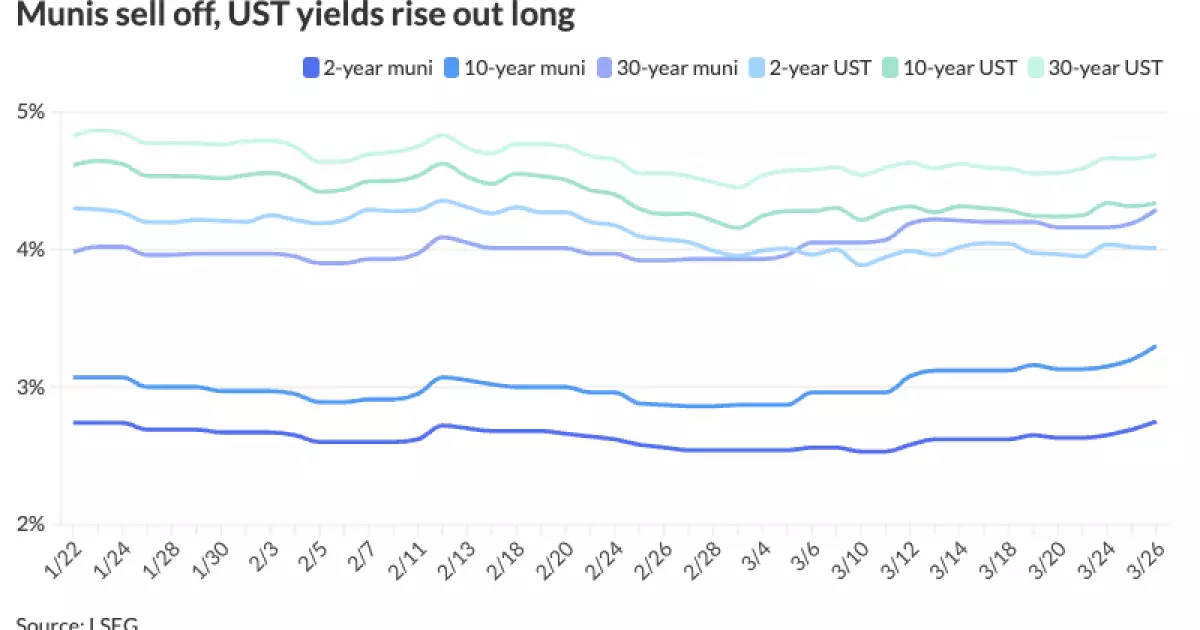The municipal bond market, an often-overlooked segment of the financial landscape, is currently undergoing a tumultuous phase. As yields manifest palpable shifts, the implications for investors, policymakers, and the broader economy cannot be understated. March 2023 has emerged as a particularly volatile month, with yields experiencing cuts in the double digits for the second time, a phenomenon warranting a deeper exploration into its causes and effects.
The Market Turbulence: Real or Perceived Risks?
Recent reports indicate a marked sell-off of municipal bonds as U.S. Treasury yields inch upwards. The dual nature of this environment—where municipal yields drop yet Treasury yields rise—creates a perplexing landscape. What’s particularly concerning is the double digit cut on municipal yields, while Treasury yields have shown resilience, leading to a potential inversion of yield curves. This contradiction raises an essential question of whether market participants are reacting to real economic data or simply succumbing to fears of instability driven by macroeconomic factors.
Factors such as rising tariffs, evolving tax policies, and fluctuating inflation rates serve as crosscurrents that complicate investment decisions. Notably, with the current administration increasingly advocating for regulation and tax changes, the municipal bond market finds itself at a critical juncture. Will these proposed policies provide clarity and stability, or will they exacerbate existing uncertainties? The prevailing sentiment among institutional investors appears to be one of caution, highlighting the delicate balance they must strike when navigating these treacherous waters.
Liquidity Strain: A Barrier to Investment
Liquidity within the municipal bond market has reached unprecedented levels of stress. James Pruskowski, CIO of 16Rock Asset Management, has aptly noted that the street is full of aggressive sellers as the quarter-end approaches. The necessity for secondary traders to rebalance their portfolios amid tightening credit spreads presents a formidable challenge. Investors are faced with the question of whether this liquidity crunch represents a buying opportunity or a forewarning of deeper systemic issues.
While some analysts argue that the widening of municipal-to-U.S. Treasury ratios could signal a relative buying opportunity for long-term investors, the immediate landscape remains fraught with risks. For well-regarded issuers such as New York City, achieving an optimal spread in such a market saturated with uncertainty presents an arduous challenge. These dynamics compel both institutional and retail investors alike to reconsider their strategies, pivoting from aggressive buying to a more reserved posture in anticipation of future dislocations.
The Role of Inflows and Outflows: Mixed Messages
The fluctuations in inflows and outflows among municipal mutual funds have further muddied the waters for market participants. In the most recent week, an influx of $19 million stood in stark contrast to the previous week’s outflow of $376 million. The contradictions extend into exchange-traded funds, which experienced inflows of $306 million after a staggering outflow of $750 million. This irregular pattern raises questions about the underlying health of the municipal market and whether these movements are indicative of a broader trend or mere market corrections.
In this context, the divergent leads from the Investment Company Institute (ICI) and LSEG evoke a sense of confusion. Are institutional investors sensing an opportunity, or are they merely reacting to momentary price adjustments? Without a solid foundation of economic data, it seemingly requires an extraordinary leap of faith for investors to commit substantial capital into this realm.
Adjusting Investment Strategies: A Call for Patience
As the municipal bond market grapples with numerous uncertainties, the prevailing strategy must revolve around patience and positioning. Observers like Pruskowski highlight the potential for market dislocation to breed opportunities; yet this requires a normative shift in how investors approach risk. Understanding that dislocations often serve as precursors to recovery should inform strategies that allow for flexibility amid volatility.
Investors must consider employing a conservative approach to yield enhancement while simultaneously recognizing that dynamics can shift quickly. Holding onto riskier positions when liquidity is strained can jeopardize not just portfolios, but also broader market stability. In this sense, it is vital for investors to remain vigilant and adaptable, steering clear of complacency as they seek to navigate the vagaries of the current economic climate.
Unmasking Our Economic Future
The events unfolding in the municipal bond market serve as a compelling microcosm of broader economic uncertainty. With the intersection of evolving tax policies, global trade tensions, and consumer sentiment, participants must engage in a more nuanced analysis of risk and opportunity. The market may indeed be searching for its catalyst, but the complex interplay of factors at play should urge investors to recalibrate their perspectives, all while grappling with the possibility that the instability plaguing the municipal sector could be a harbinger of larger economic shifts.


Leave a Reply